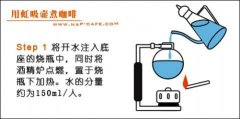Basic knowledge of fine coffee the method of brewing coffee
What do you mean "brew" coffee? Boil-put something in water and boil it over fire. But the "boiling" of brewing coffee is the process of "washing" the taste of coffee with water of 92-96 degrees. So many people will misunderstand this word. If you really put the coffee into the water to "brew", the drink you get will no longer be a cup of coffee, but a cup of scorched bitter water (because the temperature in the water has reached more than 96 degrees). The temperature above 96 degrees can destroy the oil in the coffee and taste bitter and astringent.
There are several points to pay attention to when making coffee at home:
1. The degree of grinding of coffee is determined by the coffee equipment you choose. Because different coffee making methods require different sizes of grinding powder.
2. Use 92-96 degrees water.
3. Different production methods require different cooking time.
Siphon pot method
Siphon pot, also known as "plug wind pot", is the use of siphon principle, the conditioning process is simple, cooking coffee has a special fragrant flavor, everyone can operate at any time, can experience the fun of cooking coffee, the process is full of drama. This method is especially suitable for tasting individual coffee, and it is a necessary coffee set for running a coffee shop.
Italian mocha kettle method
Using a mocha pot is a way for Italians to make coffee, which is suitable for those with a strong taste. We must pay attention to the blending quality of coffee beans, fine grinding coffee powder, and master cooking time and water. Brewing coffee at home with a mocha pot is one of the easiest ways.
Trickling filter method
Drip filter coffee requires not many utensils, convenient, sanitary, rich in DIY flavor of the brewing method. It is especially suitable for home, office and personal use.
Filter pressure method
Filter is one of the French ways to make coffee, which can fully show the quality and characteristics of coffee beans. The filter kettle is called a tea maker in China. This method is simple and requires no skill. The taste of coffee is determined by the quality of coffee beans.
Important Notice :
前街咖啡 FrontStreet Coffee has moved to new addredd:
FrontStreet Coffee Address: 315,Donghua East Road,GuangZhou
Tel:020 38364473
- Prev

Classic Italian mocha pot for making boutique coffee
The aluminum mocha pot, which can be regarded as a miracle classic, has been around for nearly a century, but its style remains basically the same, but it is still very popular. Relatively speaking, it is a coffee brewing appliance that is fast, cheap, simple and good enough. The method of making coffee in mocha pot [coffee bean content]: according to the coffee beans of 14g-18g, the water should not exceed the pressure relief valve. You can make the amount of water according to your personal preference.
- Next

Technology of making boutique coffee siphon pot brewing coffee
The siphon pot (Syphon), also known as the plug pot, always seems to remind people of the utensils of chemical experiments. However, because they are all glass containers, the whole cooking process is clearly visible, which is an excellent brewing method with excellent visual effect. In terms of taste, it is also the favorite of some coffee lovers. At the same time, the whole brewing process will be filled with a very charming aroma of coffee. So, what are you waiting for? I'm coming.
Related
- Beginners will see the "Coffee pull flower" guide!
- What is the difference between ice blog purified milk and ordinary milk coffee?
- Why is the Philippines the largest producer of crops in Liberia?
- For coffee extraction, should the fine powder be retained?
- How does extracted espresso fill pressed powder? How much strength does it take to press the powder?
- How to make jasmine cold extract coffee? Is the jasmine + latte good?
- Will this little toy really make the coffee taste better? How does Lily Drip affect coffee extraction?
- Will the action of slapping the filter cup also affect coffee extraction?
- What's the difference between powder-to-water ratio and powder-to-liquid ratio?
- What is the Ethiopian local species? What does it have to do with Heirloom native species?

